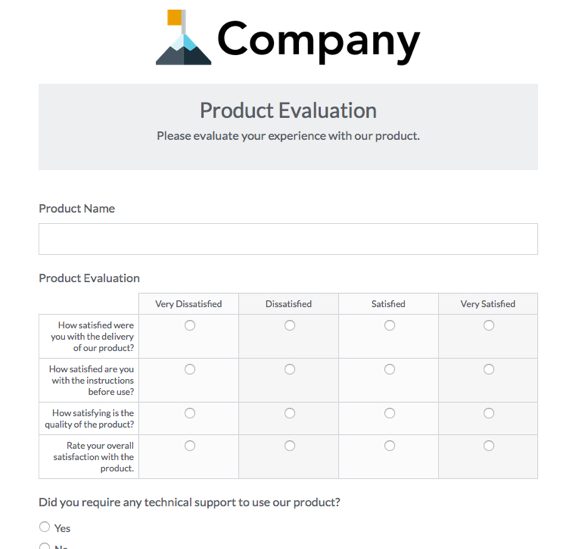Customer feedback is vital to business strategy because it allows business leaders to connect the dots between their expectations and users’ actual product experience. Because products are often designed to solve single problems, businesses can use user feedback to strengthen the bottom line of what their product is capable of doing outside the regular list of features. They can also use customer feedback to grow a line of products as users get more comfortable with sharing their thoughts and ideas.It's hard for users to leave feedback if the necessary steps have not been implemented for people to leave their input quickly and effectively. Most businesses think a simple customer feedback form at the bottom of a web page is enough, but a better way to gather feedback is to engage everyone at once with a concise set of questions that reveal the pain points of your product—as well as the possibilities that could extend the reach of your business as a product in a particular niche.
Soliciting User Feedback
Before the digital era, businesses had to send their customers physical letters with a survey form attached to them, or customers could leave written feedback in-store. These days, a business can muster up a functional and extensive customer survey or product evaluation survey in less than 10 minutes and send it out to all customers at once using email.

Customer feedback surveys are a pre-determined set of questions that give business owners insight into how satisfied customers are with the product, service, and overall business roadmap. Most surveys allow users to include experience-based suggestions or a general list of features or functionality they'd like to see added to the product. Formstack has a guide on how to start your first online survey, and it's a great starting point for anyone who hasn't had previous experience with engaging customers through survey forms.
Creating Survey Goals
It sounds easy, right? Create a survey, send out an email to all of your customers, and enjoy the feedback. It's almost that easy. The strength of your survey lies in the goals behind the survey. These goals set the tone for your survey and give you the required context to collect the exact feedback you need (in this case, we're focusing on general customer feedback about your product and product features). No matter your product or vision, you can use the general list of questions below to guide your survey creation. Answer these questions sincerely before drafting the actual survey content:
- What's the main goal of this user feedback survey?
- What are you trying to learn about your user base?
- Are there any parts of the product you are trying to improve?
- How will you use the collected survey data to improve your business?
After you document, consider, and understand your answers to each of the questions, you can start forming the questions for your first customer survey.
Asking the Right Questions
You should try to include both open-ended and closed-ended questions in your survey. Open-ended questions allow the user to leave direct feedback, while closed-ended questions are more straightforward and let the user provide input on the specifics of a particular product or feature. Nick Kellingley from Interaction Design put together a sweet roundup of general questions to ask in customer feedback surveys. His questions can help you better understand the direction to take with your questions in order to maximize the feedback you get within a single survey.
Note: Customer surveys should be sent out only every few months so as not to disturb your customers or give them the impression that something isn't working. As many as three surveys a year should be more than enough to incorporate an element of customer feedback into your overall product roadmap.
Dealing with Negative vs. Constructive Feedback
Before we move on to the last part of using user feedback to improve your bottom line, it's essential to take note of how users respond to surveys and how emotional responses can be mistaken for hard facts. While negative feedback is good to listen to because it shows you the real issues that your product has, it's vital to look at negative feedback from a neutral point of observation. Are the reported problems universal to the product, or is that a particular problem that only this particular user is experiencing? Product personalization is a great feature for any product to have, but a business should not fall prey to users who are trying to justify their own needs and desires that could better be solved through another product altogether. Encourage your customers or users to leave constructive feedback that is based on where they want to see the product heading in the future, rather than feedback based on how your product doesn't do the same things as a combination of products elsewhere.
Using Customer Feedback to Strengthen Your Bottom Line
There are three stages when conducting customer surveys. We’ve already discussed the first, which involves creating the actual survey and putting in the required focus to ensure your survey is meaningful and easy to navigate. The second stage involves sifting through the received feedback and making decisions based on what users are saying about your product or service.
Looking for Key Information in Survey Responses
Since there are a plethora of ways that users can answer your surveys and leave input, we will focus on the three main uses for surveys when it comes to improving your bottom line and generally strengthening the business-to-customer connection.
#1: Ideas
Part of the process of perfecting a particular product or its features is to understand how exactly customers are using it. Feedback surveys provide a wonderful opportunity to learn all about your users’ desires and expectations and where they think your product could be improved. It can take a significant amount of time to process all your users’ suggested ideas, but try to look for patterns and present those findings in your next meeting. There's nothing like brainstorming with the people who help to sustain your business in the first place!
#2: Improvements
Sometimes your product has a feature that sees little-to-no use. In that case, you can specifically ask about the different kinds of improvements that could be made to that feature, or to the product in general, to increase user experience. If you’re lucky, your users may suggest the perfect improvement for you to implement.
#3: Satisfaction
Closely monitor any responses you get related to customer happiness and support. These responses could highlight some previously overshadowed aspects of your product or business that are making customers unhappy. Generally, customer satisfaction surveys are run independently, but when gathering feedback on your product, you’re often gauging some level of customer satisfaction as well. The feedback you get can help you better understand the way your customer support reflects the satisfaction of your customers.
Keeping Customers in the Loop
Getting through the first two stages of conducting a customer survey isn't the end. The third and final stage is to act on all the feedback you've received. You can either thank everyone generically for their contributions, or you can do it in style and let everyone know you are beginning to implement some of the feedback in your own business strategy. There's a great feeling of satisfaction for customers when they learn that their favorite product is acting on the feedback they recommended. It reassures them that the business cares for its customers, and they'll be more likely to remain customers and promote your business to their circles of friends.
About the Author

Alex Ivanovs works as an independent contractor for businesses related to web design and web development. His work has been published by outlets such as Huffington Post, Media Temple, and Shopify. His current position is General Manager at Colorlib, where he oversees daily business operations.
Formstack has several client forms to help you with all of your data collection needs, check them out here!











